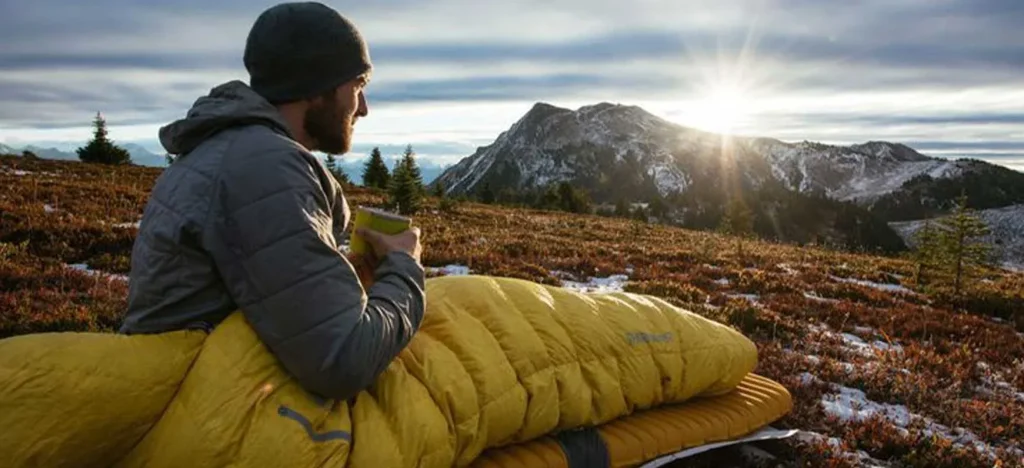Comprehensive Guide to Choosing a Mountaineering Sleeping Bag and Introducing Best-Selling Models
Choosing the Right Mountaineering Sleeping Bag
Comparing Different Types of Mountaineering Sleeping Bags
Mountaineering Sleeping Bag Buying Guide
Key Considerations for Choosing the Right Camping Sleeping Bag
Choosing a camping sleeping bag is one of the most important decisions for any camper. Ensuring comfort and safety during the trip requires attention to various factors. The first consideration is the temperature range of the sleeping bag; choose a bag that matches the climate of your camping area. The type of insulation also plays a vital role in heat retention; both down and synthetic fibers have their pros and cons. Weight and volume are other crucial factors, especially if you plan to carry the sleeping bag with you. Additionally, the length and width of the sleeping bag should suit your height and body shape for a comfortable sleep. A reputable brand and the Iran Charter price of the sleeping bag should also match your budget and the quality of the product. Finally, washability and extra features like waterproofing and internal pockets can enhance your camping experience. By following these guidelines, you can choose a suitable sleeping bag that meets your needs in various natural environments.
Types of Camping Sleeping Bags and Their Uses
Camping sleeping bags are classified into different types, each designed for specific conditions. The main types include mummy bags, rectangular bags, and semi-rectangular bags. Mummy bags, due to their snug fit around the body, provide excellent warmth retention and lighter weight, though they offer limited room for movement. On the other hand, rectangular bags provide more space for sleeping and are suitable for those who prefer more freedom of movement while sleeping, but they offer less warmth compared to mummy models. Semi-rectangular bags are a blend of the two previous models, trying to balance warmth and space. In addition, there are specialized sleeping bags like double sleeping bags and women’s models designed for specific individual needs. Choosing the type of sleeping bag depends on environmental conditions, travel style, and personal preferences. Understanding the various types of sleeping bags and their features will help you make the best choice for your camping trip.
Temperature Range for Camping Sleeping Bags: How to Choose?
The temperature range of a camping sleeping bag is one of the most critical factors to consider when selecting a sleeping bag. This range indicates the minimum temperature your sleeping bag can handle. To make a suitable choice, first determine the environmental temperature of your camping destination. Sleeping bags are usually categorized as three-season, two-season, and winter. Three-season sleeping bags are suitable for summer, spring, and autumn, while two-season bags can be used in mild winters. Winter sleeping bags are designed for extremely cold conditions and have more insulation. Besides the temperature range, factors like insulation material, sleeping bag design, and ventilation capabilities can significantly influence your decision. By carefully examining the temperature range and other features, you can select a suitable sleeping bag that keeps you warm and cozy during your camping trip.
Weight and Volume of Camping Sleeping Bags: A Guide to Lightweight Travel
One of the main challenges in camping is transporting bulky and heavy equipment. Therefore, the weight and volume of the camping sleeping bag play a significant role in your comfort. Lightweight and compact sleeping bags allow you to carry more gear and essentials without adding extra burden to your backpack. Down sleeping bags, although they retain heat well, are usually heavier and bulkier, which might pose a challenge in carrying them. On the other hand, synthetic sleeping bags are generally lighter and more compact, but they may not provide sufficient warmth in extreme cold conditions. Some manufacturers offer compact sleeping bags with smaller dimensions, making them easier to fit into backpacks. Choosing the right sleeping bag with regard to weight and volume can greatly enhance your camping experience and prevent unnecessary fatigue.
Material and Type of Insulation in Camping Sleeping Bags: Choosing According to Your Needs
The material and type of insulation in a sleeping bag are key factors in retaining warmth and ensuring a comfortable night’s sleep. Down and synthetic fibers represent the two main types of insulation. Down sleeping bags, made from natural materials like goose or duck down, retain more heat and are lighter but are more sensitive to moisture and may become heavier. Conversely, synthetic sleeping bags are made from man-made materials, which are more resistant to moisture and retain warmth even when wet, although they are heavier and bulkier than down sleeping bags. Some sleeping bags use a combination of both types of insulation to balance warmth with weight. Additionally, the outer fabric of the sleeping bag is important; waterproof and windproof fabrics can provide necessary protection against rain and wind. Choosing the right material and type of insulation depends on the environmental conditions of your trip and your personal preferences.
Dimensions and Size of Camping Sleeping Bags: Designed for Greater Comfort
The dimensions and size of a camping sleeping bag greatly affect how comfortable your sleep will be. Larger sleeping bags provide more room for movement, allowing you to sleep and move more comfortably throughout the night. These types are more suited for those who prefer the freedom to move around while sleeping. On the other hand, smaller and narrower designed sleeping bags are lighter and less bulky, better suited for shorter trips and minimalist packing. The dimensions of the sleeping bag should align with your height and body build; excessively long or short sleeping bags may lead to discomfort during sleep. Additionally, some sleeping bags are adjustably designed to allow changes in size based on need. Ultimately, a reputable brand and the quality of stitching and fabric should also be considered in the selection of dimensions and size to ensure durability and performance.
Price and Brand of Camping Sleeping Bags: Investing in Quality
The price and brand of a camping sleeping bag are crucial factors in making your purchase decision. Reputable brands typically offer higher quality and use more durable materials and better insulation, but they are also more expensive. On the other hand, cheaper sleeping bags may be suitable for short-term use or beginners, but their durability and performance in harsh camping conditions may be lower. When choosing a sleeping bag, it’s best to find a balance between quality and price; select a sleeping bag that fits your budget while meeting your warmth and weight needs. Additionally, reviewing customer feedback and expert reviews on various brands and models can help you choose the best option. Investing in a quality sleeping bag can enhance your camping experience and prevent potential fatigue and discomfort.
Washability and Maintenance of Camping Sleeping Bags
The washability and maintenance of a camping sleeping bag are important aspects to consider when choosing a sleeping bag. Sleeping bags with easy washability can be cleaned without hassle and their useful life extended. Some sleeping bags are machine washable, while others require hand washing. Before purchasing, make sure to carefully read the washing and care instructions for the sleeping bag. Additionally, the type of fabric and insulation greatly affects the washing process; down sleeping bags need more careful attention to prevent clumping and maintain shape. On the other hand, synthetic sleeping bags have better resistance to washing and require less special care. Proper maintenance of the sleeping bag during trips is also essential; keeping the sleeping bag in its proper storage sack and avoiding damage from sharp objects or excessive body weight is very important.
Additional Features of Camping Sleeping Bags: More Comfort and Functionality
Modern camping sleeping bags come with a variety of additional features that can increase their comfort and functionality. Some of these features include waterproofing, internal pockets for holding small items, hood for keeping the head and neck warm, and ventilation systems for temperature adjustment. Waterproof features allow you to protect your sleeping bag against rain and moisture, while internal pockets let you keep essential items easily accessible. The hood aids in maintaining head and neck warmth, and ventilation systems facilitate temperature control and prevent moisture build-up. Additionally, some sleeping bags have dual-side closures, allowing for air circulation and preventing sweat accumulation. Choosing a sleeping bag with additional features can enhance your camping experience, providing more comfort and functionality.
Women’s Sleeping Bags: Special Designs for Specific Needs
Women’s sleeping bags are designed to respond to the unique and different needs of women while camping. These sleeping bags are designed in terms of size and shape to be more compatible with the anatomy of women’s bodies. Usually, women’s sleeping bags have a shorter length and wider width in the hip area and a shallower fit at the shoulders to quickly warm the air and retain optimal warmth. Additionally, some women’s sleeping bag models have extra insulation layers in the foot area to retain more warmth and prevent cold feet. The quality of materials used in women’s sleeping bags is also chosen to be higher and better insulated to meet the body’s warmth needs. Moreover, suitable design for easier movement in different body dimensions is important. Choosing the right women’s sleeping bag can provide more comfortable and warmer sleep during camping nights and improve the camping experience.
Different Shapes and Categories of Camping Sleeping Bags
Camping sleeping bags are divided into three main shapes: mummy, rectangular, and semi-rectangular. Each of these shapes has its characteristics and advantages, which can be chosen based on your needs and preferences. Mummy sleeping bags with a snug fit around the body retain warmth well and have less weight and volume, but offer limited space for movement. Rectangular sleeping bags, on the other hand, provide more space for sleeping and movement and are more suitable for those who prefer to move freely in their sleep, although they offer less warmth compared to mummy models. Semi-rectangular sleeping bags combine features of the previous two models, striving to balance warmth and sleeping space. Furthermore, some sleeping bags include special technologies such as proper ventilation, waterproofing, and internal pockets that can enhance comfort and functionality. Ultimately, the choice of sleeping bag shape should be based on your thermal, spatial, and structural needs to ensure a good sleeping experience in camping environments.
Combining Material and Insulation in Camping Sleeping Bags: Best Choice for Warmth and Durability
Combining material and type of insulation in a camping sleeping bag plays a very important role in its performance. Sleeping bags made from high-quality material and proper insulation can retain warmth effectively and withstand harsh environmental conditions. Down sleeping bags, filled with goose or duck down, provide high heat insulation and are suitable for extremely cold environments, though they may be sensitive to moisture and require more care. On the other hand, synthetic sleeping bags are made from moisture-resistant materials and perform better in rain and damp conditions, but may be bulkier and heavier. Some sleeping bags use a combination of both types of insulation to retain warmth while increasing moisture resistance. Additionally, the exterior material of the sleeping bag is made from windproof and water-resistant materials to prevent the intrusion of cold air and rain. Selecting the right combination of material and insulation, depending on environmental conditions and your needs, can provide a good sleeping experience in camping environments.
Reputable Brands in Camping Sleeping Bags: Smart Choices
Undoubtedly, choosing a reputable brand is one of the important factors in purchasing a camping sleeping bag. Reputable brands with quality and tested products in different conditions gain more trust from their customers. Brands like The North Face, Deuter, and Mountain Hardwear are among the leading brands in camping sleeping bags, recognized for offering durable, warm, and comfortable products. They typically use advanced technologies in sleeping bag production and cater to various campers’ needs. Besides international brands, local brands also exist, offering quality products at competitive prices, establishing their unique place in the market. When choosing a brand, it’s wise to consider users’ reviews, expert opinions, and product warranties to ensure the sleeping bag’s quality and durability. Investing in a reliable brand’s sleeping bag can enhance your camping experience and prevent potential issues.
Guide to Choosing Women’s Sleeping Bags for Camping
Women’s sleeping bags are designed to meet the specific and different needs of women in camping. These sleeping bags are crafted in terms of size and shape to align more closely with women’s body anatomy, typically having a shorter length and wider width in the hip and foot areas to retain heat better and warm air quickly. Moreover, women’s sleeping bags are often made from materials with better insulation to meet women’s body warmth needs. Some models include extra layers in the foot area to prevent cold feet. Suitably designed for easier movement across different body dimensions is crucial; women’s sleeping bags are typically narrower at the shoulders and wider at the hips to fit women’s bodies well. Choosing the right women’s sleeping bag can provide a warmer and more comfortable sleep during camping nights and enhance the camping experience for women.
Key Features of Camping Sleeping Bags: Added Comfort and Functionality
Modern camping sleeping bags are equipped with several key features that can increase their comfort and functionality. These features include waterproofing, which prevents water and moisture intrusion and protects the sleeping bag in rainy conditions; internal pockets that allow for storing small items like mobile phones, flashlights, and gloves; having a hood to retain head and neck warmth; ventilation systems for temperature regulation and preventing moisture build-up inside the sleeping bag; and dual-side closures that allow better internal space adjustment. Additionally, some sleeping bags have extra covers like side insulation layers or wind-resistant parts that enhance their performance in various weather conditions. Selecting a sleeping bag with appropriate key features can improve your camping experience, providing added comfort and functionality in tough nighttime conditions.
Important Tips for Maintaining and Caring for Camping Sleeping Bags
Proper maintenance and care of camping sleeping bags can extend their lifespan and ensure their quality and performance. The first step in maintaining a sleeping bag is correct washing. Always follow the manufacturer’s care instructions; some sleeping bags require hand washing, while others may be machine washable. Using appropriate detergents and avoiding harsh cleaning products can help preserve the sleeping bag’s materials and insulation. After washing, thoroughly dry the sleeping bag; using a domestic dryer is not advised unless specified by the manufacturer’s instructions. Store the sleeping bag correctly in its storage bag and avoid excessive pressure on it. Regularly check for any damage on the sleeping bag’s shell or zippers and conduct necessary repairs if needed. By adhering to these guidelines, you can make the best use of your camping sleeping bag and maximize its lifespan.
A Guide to Buying Bestselling and Popular Sleeping Bags on the Market
The camping sleeping bag market offers various bestselling and popular products, each with its unique features and advantages. Choosing the best sleeping bag can be based on your personal needs and preferences. Some of the bestselling camping sleeping bags include models from The North Face, Deuter, and Mountain Hardwear, which are known for their exceptional quality, durability, and insulation. Moreover, local brands like Iran Charter provide diverse and quality sleeping bags that can be a suitable purchase option. When reviewing bestselling sleeping bags, consider aspects like temperature range, weight and volume, material and insulation type, dimensions and size, and additional features. Reading user feedback and expert reviews on each model can help select the best sleeping bag. Additionally, comparing prices and features among different models can assist in finding an appropriate sleeping bag within your budget and requirements. With a smart choice, you can acquire a popular and bestselling sleeping bag for your camping trips, ensuring a comfortable and safe experience.
FAQ
- What temperature range should I consider when buying a sleeping bag?
- You should consider the climate conditions of your camping destination and the minimum expected temperature. The temperature range is usually indicated on the sleeping bag’s label, and you should choose a model that is suitable for the destination’s temperature.
- How do weight and volume affect my choice of sleeping bag?
- If you plan to carry the sleeping bag in your backpack, it’s better to choose a lightweight and compact model for easier transport. In car camping, bulkier options can also be considered.
- What are the main differences between synthetic and down sleeping bags?
- Synthetic sleeping bags are more resistant to moisture and retain heat even when wet but are generally heavier and bulkier compared to down sleeping bags. Down sleeping bags are lighter and warmer, but their performance decreases if they get wet.
- Why does the size and dimensions of a sleeping bag matter?
- The sleeping bag should match your height and body size. Sleeping bags that are too short or too long might not allow for comfortable sleep and fail to retain warmth completely. For more space, you can choose larger models.
- What are the different kinds of sleeping bags and their pros and cons?
- Sleeping bags are classified into three main shapes: mummy, rectangular, and semi-rectangular. Mummy bags are warmer and more compact but offer limited movement space. Rectangular ones offer more space and comfort but are bulkier and less warm. Semi-rectangular bags combine features of the previous two.
- How do additional features affect the choice of a sleeping bag?
- Features like waterproofing, internal pockets, and a hood can enhance the comfort and functionality of a sleeping bag. Depending on your needs, these features can provide a better selection.
- How do price and brand affect the quality of a sleeping bag?
- Well-known brands typically offer higher quality but are also more expensive. You should establish your budget and choose accordingly. Affordable models can be suitable for casual camping.
- What features do women’s sleeping bags have?
- Women’s sleeping bags are designed according to women’s body anatomy. They are usually narrower at the shoulders and wider at the hips to better fit women’s bodies and retain warmth.
- How should I properly wash my sleeping bag?
- Always follow the manufacturer’s instructions. Generally, sleeping bags should be placed in a front-loading washing machine and washed with mild detergents. Use a dryer on low heat to avoid damaging the insulation.
- What type of insulation is best for humid environments?
- Synthetic insulation is more suitable for humid environments as it retains heat even in wet conditions, unlike down insulation, which loses effectiveness when wet.
- How does insulation level affect sleeping bag warmth?
- The type and amount of insulation directly influence the warmth, weight, and compressibility of the sleeping bag. Choosing the right insulation according to your camping needs is crucial.
- Are all-season sleeping bags suitable for all seasons?
- All-season sleeping bags offer versatility in various weather conditions but may not perform optimally in extremely cold or hot conditions. Specialized sleeping bags are recommended for specific environments.
- What is the difference between ‘comfort’ and ‘limit’ temperature ratings?
- The ‘comfort’ rating is the temperature at which an average sleeper can feel comfortable, whereas the ‘limit’ rating is the lowest temperature at which the sleeping bag can still provide warmth.
- Should a sleeping bag have a hood?
- Having a hood can increase the warmth retention of the head and neck, especially in cold conditions. This feature can enhance comfort and warmth.
- Which brands provide high-quality sleeping bags?
- Reputable brands such as The North Face, Coleman, Marmot, REI, and Mountain Hardwear are known for their durability, comfort, and excellent performance.
- How can I choose a sleeping bag for winter camping?
- For winter camping, choose a sleeping bag with a lower temperature rating and stronger insulation. Mummy models are typically suitable for cold conditions.
- Does the shape of a sleeping bag affect sleeping comfort?
- Yes, the shape of the sleeping bag significantly impacts sleeping comfort. Rectangular sleeping bags offer more movement space, while mummy bags are designed to optimize warmth but provide less room.












